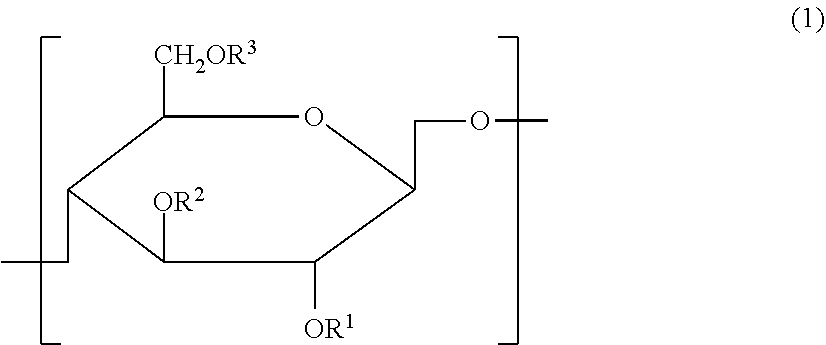Cellulose derivative and hydrogel thereof
a technology of cellulose and hydrogel, applied in the field of cellulose derivatives, to achieve the effect of high viscoelasticity, high viscoelasticity, and increased proportion of introduced substituents
- Summary
- Abstract
- Description
- Claims
- Application Information
AI Technical Summary
Benefits of technology
Problems solved by technology
Method used
Image
Examples
example 1
Synthesis of H2N—CH2—CO—(O—CH2CH2)7—O—C18H35
[0057]After dissolving 1 millimole of N-butyloxycarbonylglycine (Boc-Gly-OH, Wako Pure Chemical Industries, Ltd.) with respect to 1 millimole of oleyl alcohol polyethyleneglycol ether (H—(O—CH2CH2)7—O—C18H35, Wako Pure Chemical Industries, Ltd.) in dichloromethane, a dichloromethane solution containing 1 millimole of dicyclohexylcarbodiimide (Wako Pure Chemical Industries, Ltd.) as a condensation agent was added dropwise at room temperature. The reaction mixture was filtered to remove the dicyclohexylurea by-product and then concentrated and dried to obtain an amino group-protected intermediate (Boc-NH—CH2—CO—(O—CH2CH2)7—O—C18H35).
[0058]Approximately 1-2 ml of trifluoroacetic acid (Wako Pure Chemical Industries, Ltd.) was added to the intermediate, and de-Boc reaction by acid treatment was conducted at room temperature for 2 hours. Progress of the reaction was confirmed by TLC. The reaction mixture was concentrated under reduced pressure,...
example 2
[0059]Coupling of carboxymethylcellulose (CMC-Na) and H2N—CH2—CO—(O—CH2CH2)7—O—C18H35
[0060]After dissolving 200 mg of CMC-Na (F600 MC, degree of substitution: 0.69, Nippon Paper Chemicals Co., Ltd.) in 40 ml of water, 40 ml of tetrahydrofuran was further added and mixed therewith to obtain a homogeneous solution. The trifluoroacetate of H2N—CH2—CO—(O—CH2CH2)7—O—C18H35 synthesized in Example 1 was added and mixed at 0.2 equivalent to 1 equivalent of carboxyl groups in the CMC-Na.
[0061]After dissolving EDC (1-ethyl-3-[3-(dimethylamino)propyl]carbodiimide.HCl (Wako Pure Chemical Industries, Ltd.) and HOBt.H2O (1-hydroxybenzotriazole.monohydrate, Wako Pure Chemical Industries, Ltd.), at 1.1 equivalents each to H2N—CH2—CO—(O—CH2CH2)7—O—C18H35, in 10 ml of tetrahydrofuran / water=1 / 1, the solution was added to the reaction system and the mixture was stirred overnight. After stirring, the reaction mixture was concentrated with a rotary evaporator to remove the tetrahydrofuran, the water was...
example 3
Preparation of Hydrogel
[0062]A 10 mg portion of the cellulose derivative obtained in Example 2 was dissolved in 1990 mg of ion-exchanged water to prepare a hydrogel with a concentration of 0.5 wt %. The obtained hydrogel was colorless transparent, did not flow when the container was inclined, allowed easy insertion of a metal spatula such as a flat spoon, and could be easily pushed through a 25G injection needle.
[0063]The complex elastic modulus of the obtained hydrogel was measured to be 177 N / m2. The complex elastic modulus of the hydrogel was measured at 37° C. with an angular velocity of 10 rad / sec, using a Rheometer RFIII (TA Instrument) as the dynamic viscoelasticity measuring apparatus.
PUM
| Property | Measurement | Unit |
|---|---|---|
| temperature | aaaaa | aaaaa |
| temperature | aaaaa | aaaaa |
| temperature | aaaaa | aaaaa |
Abstract
Description
Claims
Application Information
 Login to View More
Login to View More - R&D
- Intellectual Property
- Life Sciences
- Materials
- Tech Scout
- Unparalleled Data Quality
- Higher Quality Content
- 60% Fewer Hallucinations
Browse by: Latest US Patents, China's latest patents, Technical Efficacy Thesaurus, Application Domain, Technology Topic, Popular Technical Reports.
© 2025 PatSnap. All rights reserved.Legal|Privacy policy|Modern Slavery Act Transparency Statement|Sitemap|About US| Contact US: help@patsnap.com


